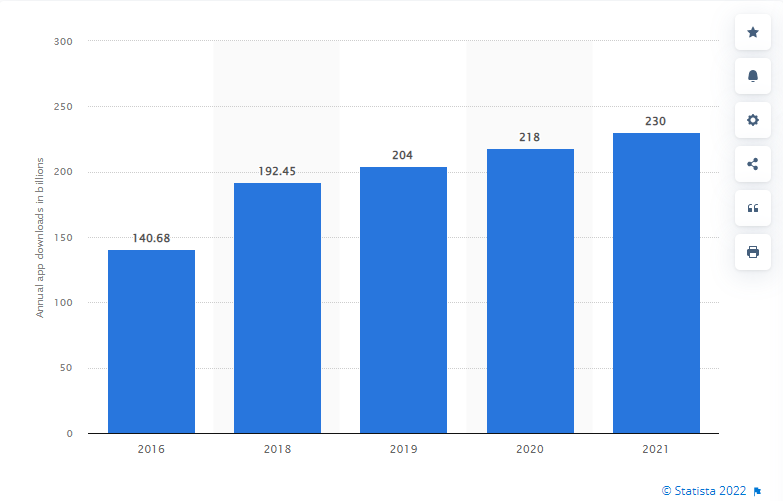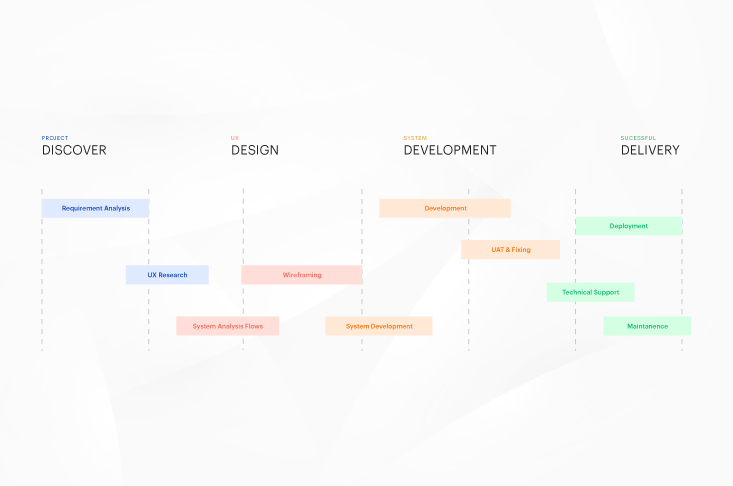Smartphones have become an all-inclusive one-stop solution for every possible need people might have, all thanks to the geniuses who make innovative and useful applications. People rely on different apps to carry out their daily activities ranging from business, office work, education, organizing tasks, banking, shopping, and the list goes on and on with just a few taps on their phones.
Each day, new mobile apps are released, or old ones are updated to become more valuable. These apps are incredibly useful, entertaining, and/or informative with an app being there to fit every occasion!
With the sheer volume of downloads each day on the app stores, it is no surprise that good apps go a long way with their target audience. This is why proper mobile application development is essential for business success.
Checklist
Why do we need mobile app development?
Mobile applications are incredibly useful for day-to-day functioning. From important communication tools to leisure time activities – mobile apps provide immense convenience to users right in the palm of their hands.

Recent trends show significant growth in the volume of app downloads over the years, and the numbers are still on the rise. In 2021, apps were downloaded over 230 billion times across the world on both Apple and Android platforms.
Why is it important to maintain quality with app development?
There are thousands – if not millions – of apps available for mobile phones, so each app must offer something great to stand out from the crowd. The quality of an app makes or breaks its success, so maintaining optimal quality in development is paramount.
The standards for mobile apps are higher than ever before in terms of performance and usability, therefore, without quality maintenance, apps can even be pulled out from the app store for not meeting the minimum requirements.
Mobile Application Development – Best Practices
As a mobile app developer, you have a responsibility to provide your clients with the best quality of work. Below we have laid out 5 best practices that every developer should ensure to create outstanding mobile applications.
Determine the Purpose of the App

Before you begin the project, it’s essential to spend a decent amount of time conducting research. As a developer, you need to properly understand what you are trying to achieve by creating this app, or at least understand what exactly the client is looking for. Some big questions to answer include:
- Why are we making it?
This is the most important question that needs to be answered. Every mobile app serves a specific purpose or a set of functions. You need to properly understand the purpose and the outcome to map out the app development, else it can lead to a lot of miscommunications and errors down the line. Determining the outcome will help you visualize an end goal and plan and execute the development process accordingly. - Who are we making it for?
Define the target demographic for your app, this will come in handy when you’re developing the interface. For example, an older demographic will prefer an easy-to-use interface that is simplified and convenient. With a younger demographic, however, you want to make the appearance vibrant and smooth. Aside from appearance, determining the demographic will help you create the content itself and optimize it accordingly. -
What is the desired outcome?
What is the client hoping to achieve with this app? Is it better sales, more awareness, or something else? Knowing what is expected after launching the app will give you powerful insight into how to develop the app effectively.
Jot Down the Development Strategy
Strategies and preliminary plans are very important. Set out your objectives and scope of work, and note down key deliverables and receivables. At this stage, there are a few more questions you will need to answer:
- Who are the competitors?
First, it’s essential to take note of the competitors. Know how the industry is operating and look for a gap that you can fill. Figure out the norm in the specific field and get an idea of the direction you need to take. It is a good idea to gather intel from existing successful apps as they know what users are looking for and are effectively catering to their needs. Take inspiration from them and create something even better! - What is the Unique Value Proposition?
You need to clearly state the purpose of the app and how it can benefit the users. What is so special about the app? What is something inventive that you are providing with it that no one else is? The UVP is critical to making the app stand out.
What are the steps of the project?
It’s important to maintain a standard workflow process throughout the project so you do not accidentally miss out on a step. Having a step-by-step project flowchart mapped out helps keep your team aligned – regardless of whether you work using an Agile or Waterfall strategy.
Here’s a standard process flow for app development:

Prioritize User-Friendliness
User-friendliness is of the utmost importance. A difficult-to-use app will quickly discourage users from using it, no matter how important its function is. At this step, it is important to answer two key questions:
How to make the app user-friendly?
- Make easy onboarding the #1 priority
Easy onboarding should be the top priority as it determines app success. If users have to go through a lengthy onboarding process they will quickly become discouraged and uninstall the app – that’s a big problem! - Utilize Push Notifications
Push notifications, if used correctly, can entice users to come back to the app. With some apps, sending out important reminders regularly (e.g. for important meetings or deadlines) via push notifications can greatly improve user-friendliness. - Make the App Interface Intuitive
The functions of the app need to make sense. The algorithm needs to correspond properly and have a logical sequence of events that is easy for users to understand. - Consider Good Accessibility for All Demographics
Inclusivity is very important in this day and age, so make sure you include features that consider disabilities. Something as simple as a high contrast mode can be very helpful for the visually impaired, or a text-to-speech mode might be effective as well, among other accessibility features. - Determine Features for a Good Offline Experience
Sometimes users might not have access to the internet, and it’s important to consider this for the app. Many apps simply refuse to load without a connection, and those leave a very negative impression in the user’s mind.
Make the App Secure
Nowadays most apps require personal information. eCommerce apps have the option for you to save your payment information, and it should not come as a surprise that this kind of information requires the highest security measures to be in place. Security should be one of the top priorities – regardless of whether it’s an eCommerce app or a game.
What are some steps you can take to secure the app?
- Encrypt the source code
- Conduct penetration tests
- Include high-level authentication
- Secure the backend system
- Minimize storage of sensitive data
Ensure Proper QA and Testing
As with all development processes, app development requires a fair bit of QA and testing. Improper testing and inspection before release can be detrimental to the reputation of the app in the eyes of users.
What kind of tests should you do on Mobile Apps?
Certain apps go through dozens, or even hundreds, of tests throughout their development. The more types of tests conducted, the better for the final product. Some of the most common mobile app tests include:
- Localization Testing
- Memory Leak Testing
- Usability Testing
- Security Testing
- UI/UX Testing
- User Testing
- Functional Testing
- Platform and Device Testing
When to conduct QA and testing?
Quality assurance should be an ongoing process throughout the lifetime of the project. There should be a checkpoint after every significant progress step so that you can ensure the project is going in the direction you need it to, devoid of any errors.
Testing is usually done at the end of the project, but it can be advised to conduct tests during the earlier stages – like during the prototype stage or when developing the minimum viable product.
Conclusion
Mobile applications have revolutionized how we function on a daily basis. With so many applications to choose from, users have become a lot more selective about the apps they use. It is now pertinent to stay on top of the game and create apps that are impossible to resist. To do this, developers have to take a strong strategic approach to the development and deployment of mobile applications.
If you’re currently looking for good developers to build a mobile application for you, make sure you research the available companies in the market to ensure they uphold the above-mentioned best practices.
Frequently Asked Questions (FAQs)
How to tell if a mobile app will be successful?
It really boils down to luck, but some factors that can help you succeed include creating an app that is relevant, useful, or in trend. The quality of the app, even the size of the download file, can impact the success rate.
How to protect your app idea during development?
It’s always a good idea to have a strong contract in place that explicitly specifies that the developer has no right to share any of the details with others. If you have a sizeable organization for which you are creating the app, you can also get copyright ownership.
How often should apps be updated?
It is ideal to update apps at least once a month to keep up with the latest trends, demands, and security measures.
How much does it cost to develop a mobile app?
On average, developing a mobile app can cost anywhere between $5,000-$10,000. For more complex apps with a lot of features and upkeep, it can cost much higher.


